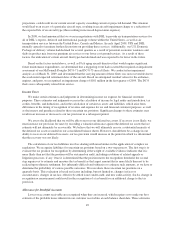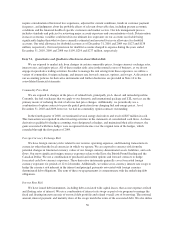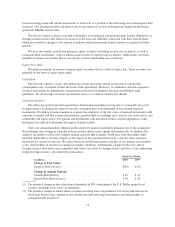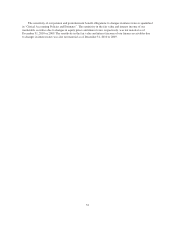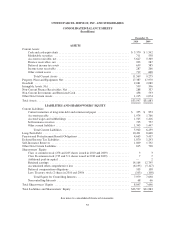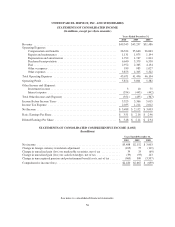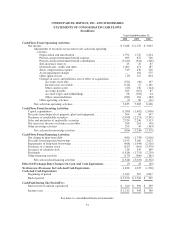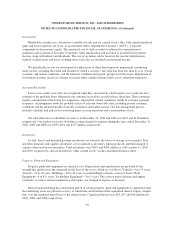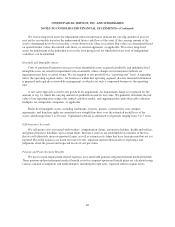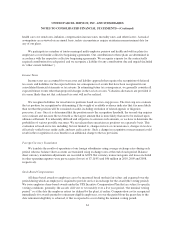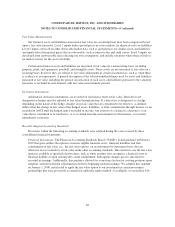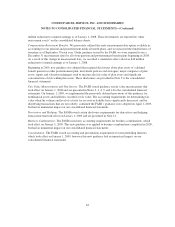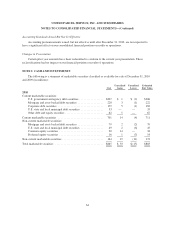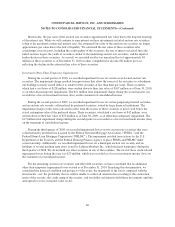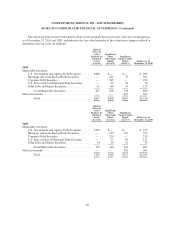UPS 2010 Annual Report Download - page 71
Download and view the complete annual report
Please find page 71 of the 2010 UPS annual report below. You can navigate through the pages in the report by either clicking on the pages listed below, or by using the keyword search tool below to find specific information within the annual report.UNITED PARCEL SERVICE, INC. AND SUBSIDIARIES
NOTES TO CONSOLIDATED FINANCIAL STATEMENTS—(Continued)
Investments
Marketable securities are classified as available-for-sale and are carried at fair value, with related unrealized
gains and losses reported, net of tax, as accumulated other comprehensive income (“AOCI”), a separate
component of shareowners’ equity. The amortized cost of debt securities is adjusted for amortization of
premiums and accretion of discounts to maturity. Such amortization and accretion is included in investment
income, along with interest and dividends. The cost of securities sold is based on the specific identification
method; realized gains and losses resulting from such sales are included in investment income.
We periodically review our investments for indications of other than temporary impairment considering
many factors, including the extent and duration to which a security’s fair value has been less than its cost, overall
economic and market conditions, and the financial condition and specific prospects for the issuer. Impairment of
investment securities results in a charge to income when a market decline below cost is other than temporary.
Accounts Receivable
Losses on accounts receivable are recognized when they are incurred, which requires us to make our best
estimate of the probable losses inherent in our customer receivables at each balance sheet date. These estimates
require consideration of historical loss experience, adjusted for current conditions, trends in customer payment
frequency, and judgments about the probable effects of relevant observable data, including present economic
conditions and the financial health of specific customers and market sectors. Our risk management process
includes standards and policies for reviewing major account exposures and concentrations of risk.
Our total allowance for doubtful accounts as of December 31, 2010 and 2009 was $127 and $138 million,
respectively. Our total provision for doubtful accounts charged to expense during the years ended December 31,
2010, 2009 and 2008 was $199, $254 and $277 million, respectively.
Inventories
Jet fuel, diesel, and unleaded gasoline inventories are valued at the lower of average cost or market. Fuel
and other materials and supplies inventories are recognized as inventory when purchased, and then charged to
expense when used in our operations. Total inventories were $319 and $281 million as of December 31, 2010
and 2009, respectively, and are included in “other current assets” on the consolidated balance sheet.
Property, Plant and Equipment
Property, plant and equipment are carried at cost. Depreciation and amortization are provided by the
straight-line method over the estimated useful lives of the assets, which are as follows: Vehicles—6 to 15 years;
Aircraft—12 to 30 years; Buildings—20 to 40 years; Leasehold Improvements—terms of leases; Plant
Equipment—6 to 8
1
⁄
4
years; Technology Equipment—3 to 5 years. The costs of major airframe and engine
overhauls, as well as routine maintenance and repairs, are charged to expense as incurred.
Interest incurred during the construction period of certain property, plant and equipment is capitalized until
the underlying assets are placed in service, at which time amortization of the capitalized interest begins, straight-
line, over the estimated useful lives of the related assets. Capitalized interest was $18, $37 and $48 million for
2010, 2009, and 2008, respectively.
59


